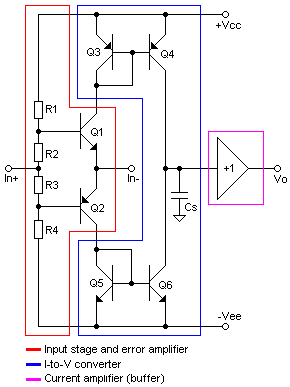Hi everyone !
PLEASE CORRECT ME IF I'M WRONG !!!!
So after lots of late nights and reading through Wikipedia and a electronic book called Crecraft Gorham and Sparkes ELECTRONICS I got most of the engineering behind amplifiers and power supplies and SMPS.
So now im trying do understand how Soulution amps work.
The stuff they write:
"From the input the soulution 711 first buffers the music signal. A high performance correction amplifier is then used to capture and correct any deviations in the signal, very quickly and very precisely. Ultra wideband amplification using no feedback loops follows, a less than 10 nanosecond transit time and level accuracy to within 0.1 dB ensuring signal purity. The whole is housed within a sealed module, maintaining a common temperature across all stages to further guarantee precision. The output stage comprises 14 power transistors per channel, all mounted onto a massive copper rail which is temperature controlled for a constant quiescent current. The soulution 711’s impressive low level signal handling is reflected in its raw power delivery. Current levels of 120 A and more are readily attainable."
Thats from their website.
So...
This is from a report on Fairaudio: (In German) (http://www.fairaudio.de/dwt/artikel/2010-firmenberichte/soulution-audio-verstaerker-cd-player-spemot-bericht-2.html)
"Mit seinem einzigartigen Spannungskontrollverstärker mit fest eingestellter Verstärkung und einer Bandbreite bis 80 MHz (linkes Bild; die aufrecht stehenden Platinen haben Silber-Anschlusspins; das Modul ist in Kunststoff vergossen) und einer dreistufigen Strom-Pufferstufe wurde die Feedback-Schleife des Verstärkers um den Faktor 10 verkürzt, um die Arbeitsgeschwindigkeit zu optimieren und Fehler zu minimieren. Seine Stromquellen arbeiten mit einer Bandbreite von 10 bis 100 MHz. Die Ausgangsimpedanzen dieser Netzteile werden sehr niedrig gehalten. „Das Signal passiert meine Spannungsverstärkungsstufe in ungefähr 10 Nanosekunden mit einer maximalen Fehleramplitude von 0,1 dB. Um dieses Niveau an Präzision zu erreichen, brauche ich natürlich konstante thermische Bedingungen.“"
Translated:
With its unique voltage control amplifier design with fixed gain and a bandwidth up to 80 MHz (left picture, the upright circuit boards have silver terminal pins, the module is molded in plastic) and a three-stage current buffer stage, the feedback loop of the amplifier was decreased by the factor 10 to optimize the working speed and minimize errors. Its current sources (power supply) operate with a bandwidth of 10 to 100 MHz. The output impedances of these power supplies are kept very low. "The signal passes through my voltage gain stage in approximately 10 nanoseconds with a maximum error amplitude of 0.1 dB. To achieve this level of precision, of course, I need constant thermal conditions. "
So after some research i found this:
Maybee I finally figured out what they use.... Or a modified version of the design...
https://en.wikipedia.org/wiki/Current-feedback_operational_amplifier
A Servus from
Max
PLEASE CORRECT ME IF I'M WRONG !!!!
So after lots of late nights and reading through Wikipedia and a electronic book called Crecraft Gorham and Sparkes ELECTRONICS I got most of the engineering behind amplifiers and power supplies and SMPS.
So now im trying do understand how Soulution amps work.
The stuff they write:
"From the input the soulution 711 first buffers the music signal. A high performance correction amplifier is then used to capture and correct any deviations in the signal, very quickly and very precisely. Ultra wideband amplification using no feedback loops follows, a less than 10 nanosecond transit time and level accuracy to within 0.1 dB ensuring signal purity. The whole is housed within a sealed module, maintaining a common temperature across all stages to further guarantee precision. The output stage comprises 14 power transistors per channel, all mounted onto a massive copper rail which is temperature controlled for a constant quiescent current. The soulution 711’s impressive low level signal handling is reflected in its raw power delivery. Current levels of 120 A and more are readily attainable."
Thats from their website.
So...
This is from a report on Fairaudio: (In German) (http://www.fairaudio.de/dwt/artikel/2010-firmenberichte/soulution-audio-verstaerker-cd-player-spemot-bericht-2.html)
"Mit seinem einzigartigen Spannungskontrollverstärker mit fest eingestellter Verstärkung und einer Bandbreite bis 80 MHz (linkes Bild; die aufrecht stehenden Platinen haben Silber-Anschlusspins; das Modul ist in Kunststoff vergossen) und einer dreistufigen Strom-Pufferstufe wurde die Feedback-Schleife des Verstärkers um den Faktor 10 verkürzt, um die Arbeitsgeschwindigkeit zu optimieren und Fehler zu minimieren. Seine Stromquellen arbeiten mit einer Bandbreite von 10 bis 100 MHz. Die Ausgangsimpedanzen dieser Netzteile werden sehr niedrig gehalten. „Das Signal passiert meine Spannungsverstärkungsstufe in ungefähr 10 Nanosekunden mit einer maximalen Fehleramplitude von 0,1 dB. Um dieses Niveau an Präzision zu erreichen, brauche ich natürlich konstante thermische Bedingungen.“"
Translated:
With its unique voltage control amplifier design with fixed gain and a bandwidth up to 80 MHz (left picture, the upright circuit boards have silver terminal pins, the module is molded in plastic) and a three-stage current buffer stage, the feedback loop of the amplifier was decreased by the factor 10 to optimize the working speed and minimize errors. Its current sources (power supply) operate with a bandwidth of 10 to 100 MHz. The output impedances of these power supplies are kept very low. "The signal passes through my voltage gain stage in approximately 10 nanoseconds with a maximum error amplitude of 0.1 dB. To achieve this level of precision, of course, I need constant thermal conditions. "
So after some research i found this:

Maybee I finally figured out what they use.... Or a modified version of the design...
https://en.wikipedia.org/wiki/Current-feedback_operational_amplifier
A Servus from
Max















